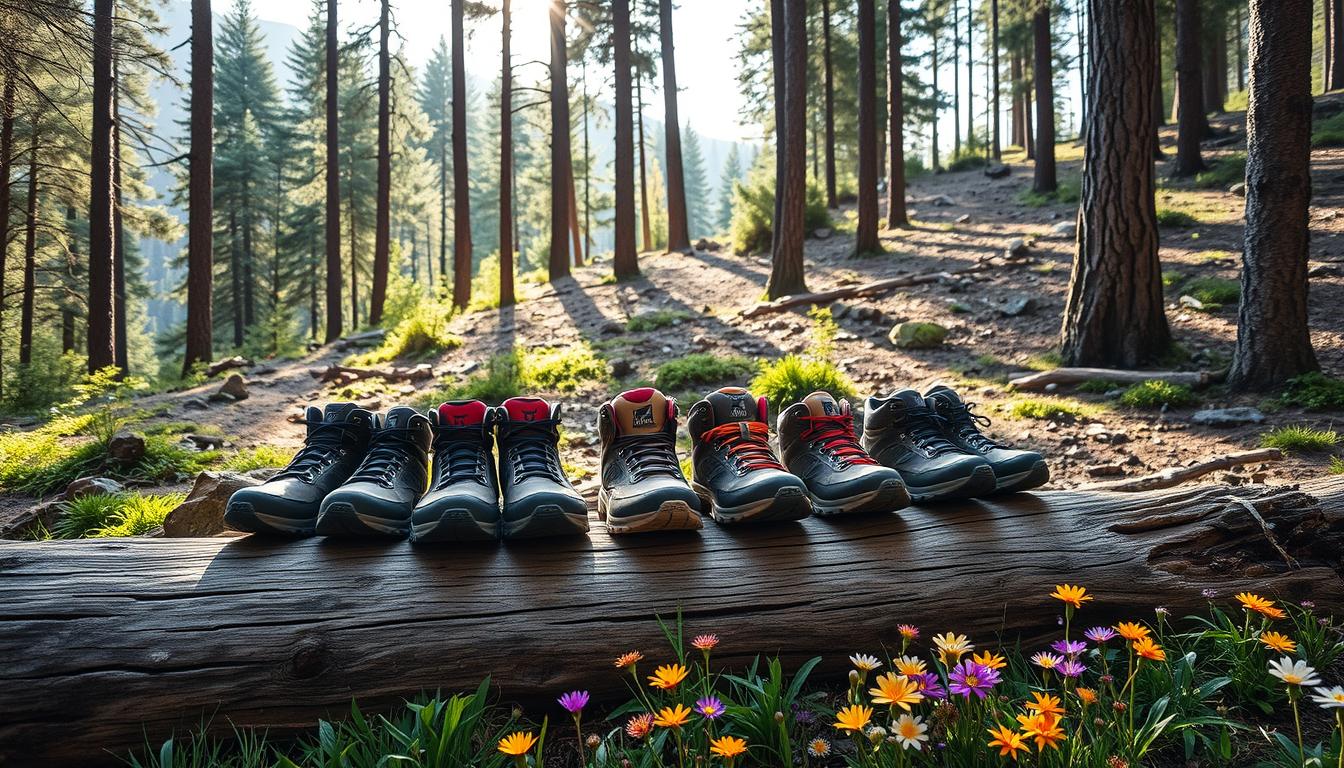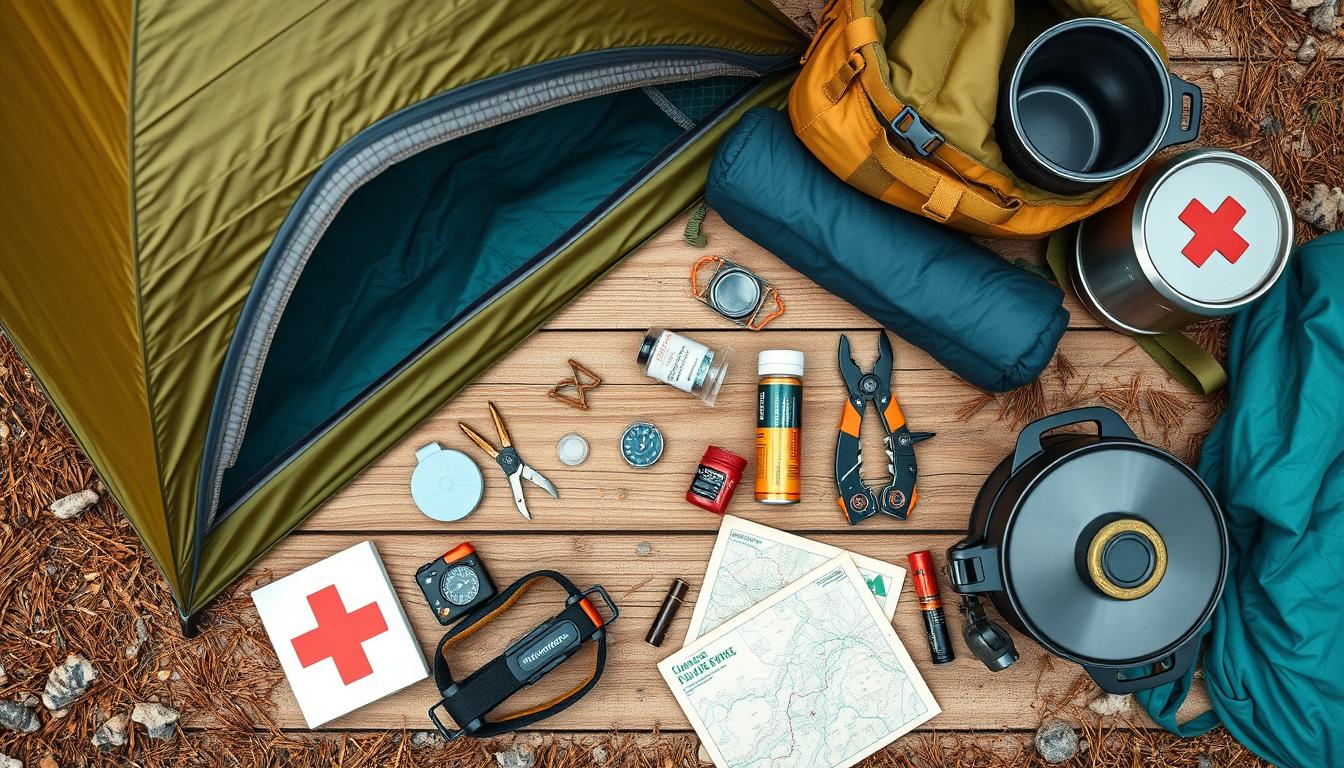When you head out into nature, the right gear is key. This includes your hiking boots. Knowing how to pick the best boots can greatly improve your camping trip. Good boots keep your feet safe and help you move better on trails.
In this guide, we’ll cover what to look for in hiking boots. We’ll make sure you find the perfect pair for your adventures. This way, you can tackle trails with confidence and comfort.
Key Takeaways
- Quality hiking boots are vital for comfort and safety during camping trips.
- Proper footwear can enhance your performance on rugged terrain.
- Consider the specific hiking conditions you will encounter.
- Find boots that fit well and cater to your unique hiking style.
- Understand the various types of hiking boots to match your needs.
- Regular maintenance can prolong the life of your hiking boots.
Understanding the Importance of Quality Hiking Boots
Choosing quality hiking boots is key for outdoor adventures. They offer the protection and support needed for various terrains. This boosts comfort and performance. Without the right boots, you might face discomfort and increased injury risk.
Protection from the Elements
Quality hiking boots protect against outdoor challenges. Rain, mud, and rocky trails can harm regular shoes. Waterproofing is crucial, keeping your feet dry in wet conditions.
Robust materials also add durability. They protect against sharp objects on the trail.
Impact on Comfort and Performance
Comfort is vital during long hikes. Quality hiking boots support natural foot movement, reducing fatigue. They offer cushioning, arch support, and shock absorption.
This greatly affects your performance and enjoyment. Good outdoor footwear can make hikes longer and more enjoyable. It keeps you comfortable, allowing you to enjoy the trek without discomfort.
| Feature | Description | Importance |
|---|---|---|
| Waterproofing | Prevents water from entering while keeping your feet dry. | Essential for wet conditions. |
| Cushioning | Absorbs shock and provides comfort. | Reduces fatigue and enhances comfort. |
| Support | Stabilizes the foot and ankle. | Prevents injuries like sprains and blisters. |
Factors to Consider When Choosing Hiking Boots
Choosing the right hiking boots is key for a comfortable and safe hike. The terrain and weather conditions are crucial. They help determine the best boots for your adventure.
Terrain Type
The terrain affects the boots’ support and grip. Rocky trails need boots with strong traction and ankle support. For muddy or wet areas, look for boots with slip-resistant soles.
Flat trails might allow for lighter boots. But, off-trail hiking needs sturdy, reinforced boots. Knowing this helps in picking the right boots.
Weather Conditions
Weather also matters when picking hiking boots. In wet climates, waterproof boots keep your feet dry. For warmer areas or summer hikes, breathable boots are better.
Good ventilation prevents overheating and moisture inside the boots. This makes your hike more enjoyable.
| Terrain Type | Recommended Boot Features |
|---|---|
| Rocky | Excellent traction, ankle support |
| Muddy | Slip-resistant soles, waterproofing |
| Flat | Lightweight, flexible design |
| Rugged Off-Trail | Sturdy construction, reinforced protection |
How to Choose the Right Hiking Boots for Camping Trips
Choosing the right hiking boots is crucial for a great camping trip. A good guide helps by considering your foot shape, size, and hiking plans. Look for boots with strong ankle support, good traction, and a comfortable fit.
Visiting outdoor stores is a smart move. The staff there can offer advice based on your needs. Trying on different boots helps you compare and choose wisely.
Here are the main features to look for:
- Ankle Support: Keeps you stable on rough ground.
- Traction: Keeps you safe on slippery or rocky paths.
- Fit: A snug fit prevents blisters and keeps you comfortable.
In short, picking the right boots depends on your preferences and the terrain. Exploring all options ensures a better camping trip.
Key Features of Hiking Boots
Exploring the outdoors requires the right gear. Hiking boots’ features greatly impact your trail experience. We’ll look at waterproofing, breathability, and support and stability.
Waterproofing
Waterproof hiking boots are crucial for wet or muddy trails. They keep your feet dry and comfy. Brands use Gore-Tex or special linings for this.
With waterproofing, you can enjoy your hike without wet socks or blisters.
Breathability
Breathability is key for comfort on warm days. Boots that let moisture out are a big plus. Look for mesh panels or breathable membranes.
This helps manage sweat and keeps you cool. It makes hiking more enjoyable.
Support and Stability
Support and stability are essential for long hikes or heavy loads. Good boots have cushioned midsoles and stiff outsoles. They also have protective toe caps.
These features ensure comfort and safety on different terrains. Ankle support is crucial to avoid injuries.

| Feature | Description | Benefits |
|---|---|---|
| Waterproofing | Creates a barrier against water | Keeps feet dry in wet conditions |
| Breathability | Allows moisture to escape | Increases comfort on warm days |
| Support and Stability | Provides cushioning and structure | Prevents injuries and reduces fatigue |
Finding the Perfect Fit
Finding the right hiking boot fit is key for a great hike. Boots that don’t fit right can cause pain and even harm. It starts with looking at size charts from different brands. These charts help pick the right size for your feet.
Size and Sizing Charts
Using size charts helps find the right hiking boots. Each brand sizes differently, so it’s important to check their charts. The size affects comfort, so measuring your feet accurately is crucial.
Width and arch height also play a role in how boots fit. These details can make a big difference.
Trying Before You Buy
Trying on hiking boots before buying is the best way. I pick a few sizes and wear the socks I’ll use hiking. Then, I walk around to see how they feel.
A good fit is snug but not too tight. It’s important to check the heel and toe room. A comfortable fit is essential for a fun hike.
The fit of hiking boots is crucial for a good hike. By looking at size charts and trying boots on, I can pick boots that make my hikes comfortable. For more tips, check out selecting hiking boots advice.
Types of Hiking Boots
Choosing the right hiking boots is key for a comfortable and safe hike. There are low-cut, mid-cut, and high-cut boots available. Each type is best for different terrains and hiking levels.
Low-Cut vs. Mid-Cut vs. High-Cut
Low-cut boots are light and offer little ankle support. They’re great for easy hikes or smooth trails. They’re also easy to carry, perfect for day hikes.
Mid-cut boots balance comfort and support. They’re good for trails that are a bit tougher and for light backpacking. High-cut boots have extra ankle support. They’re best for tough terrains and heavy loads.
Performance vs. Casual Hiking Boots
It’s important to know the difference between performance and casual boots. Performance boots are for tough activities. They have durable materials, are waterproof, and have great traction.
Casual hiking boots focus on comfort. They’re good for easy walks and less challenging places.
| Type of Boot | Support Level | Best For | Weight |
|---|---|---|---|
| Low-Cut Boots | Minimal | Casual Hiking | Lightweight |
| Mid-Cut Boots | Moderate | Moderate Trails | Moderate |
| High-Cut Boots | Maximum | Rough Terrain | Heavier |
Hiking Boot Brands to Consider
Choosing the right hiking boots is easier when I know about different brands. Each brand offers something special, like durability, comfort, or support for various terrains.
Popular Options
Merrell, Salomon, and Columbia are among the top brands. Merrell is known for comfy and rugged boots, perfect for long hikes. Salomon offers lightweight boots for high performance. Columbia has great waterproof options for rainy days.
Each brand has its own strengths. I look closely at these when picking my gear.
Brand Reputation and Reviews
Looking into brand reputation and reading reviews helps me find reliable boots. Customers share their experiences, talking about a boot’s durability and comfort. This helps me choose the best boot for my adventure.
| Brand | Best For | Key Features |
|---|---|---|
| Merrell | Comfort and Versatility | Lightweight, supportive cushioning, excellent grip |
| Salomon | Performance and Speed | Lightweight, breathable materials, advanced traction |
| Columbia | Wet Weather | Waterproofing, durability, great insulation |
Tips for Maintaining Your Hiking Boots
Keeping your hiking boots in top shape is key. Regular care boosts their performance and keeps them looking good. Here are some tips for cleaning and waterproofing your boots.
Cleaning and Waterproofing
It’s important to clean your boots after each use. This removes dirt, mud, and salt. Here’s how I do it:
- Remove laces and insoles.
- Use a soft brush to scrub off any loose dirt.
- Prepare a mixture of warm water and mild soap.
- Wipe the boots with a damp cloth, ensuring I reach all the crevices.
- Rinse with clean water and let them air dry, avoiding direct sunlight.
After cleaning and drying, I apply waterproofing treatments. These can be sprays or wax. They protect against water and prevent damage. It’s crucial to check the waterproofing often to keep my boots safe.
Storage Best Practices
Storing your boots right is also important. I keep them in a cool, dry place, away from heat. Using boot trees helps them keep their shape. Here are some storage tips:
- Keep boots away from direct sunlight.
- Store in a breathable bag to allow air circulation.
- Avoid stacking other items on top of them.
By following these tips, my boots stay in great condition. They’re always ready for my next adventure.

| Maintenance Activity | Frequency | Purpose |
|---|---|---|
| Clean boots | After each hike | Remove dirt and prevent wear |
| Waterproofing treatment | Monthly or as needed | Maintain water resistance |
| Check laces and insoles | Before every hike | Ensure comfort and fit |
| Store properly | Daily | Maintain shape and function |
The Role of Insoles and Socks in Comfort
When you’re getting ready for a hike, don’t forget about insoles and socks. They play a big role in how comfortable you’ll be. Choosing the right insoles and socks can make your hike better.
Choosing the Right Insoles
Insoles for hiking boots add extra support and cushioning. They help take pressure off your feet during long walks. There are many types to pick from:
- Custom Insoles: Made just for you for the best comfort.
- Gel Insoles: Great for absorbing shock on tough trails.
- Orthotic Insoles: Made for people with foot problems.
Sock Materials and Thickness
The socks you wear are key to comfort on a hike. Look for ones that wick away moisture to keep you cool. The thickness of your socks also matters, as it affects warmth and fit.
| Material | Benefits | Recommended Sock Thickness |
|---|---|---|
| Wool | Keeps you warm and controls moisture | Medium to thick |
| Synthetic | Strong and dries fast | Light to medium |
| Cotton | Soft but holds moisture | Medium |
By picking the right insoles and socks, you can make your hike more comfortable. This helps avoid blisters and discomfort. Spending time on these choices makes your hikes enjoyable and free from pain.
Budget Considerations for Hiking Boots
When looking for hiking boots, budget is key. It’s possible to find good boots that fit your budget. Knowing the price ranges helps you choose without losing important features.
Finding Quality on a Budget
It’s important to know the difference between cheap and quality boots. Many brands offer durable boots at affordable prices. Look for waterproofing, support, and breathability. You can find great deals by doing your research.
Price Ranges and What to Expect
Boots’ prices vary based on materials, brand, and features. Here’s a guide to help you shop:
| Price Range | Quality Indicators | Recommended Brands |
|---|---|---|
| Under $100 | Entry-level, basic features, moderate durability | Hi-Tec, Merrell (select models) |
| $100 – $200 | Good balance of features and durability, reliable support | Columbia, North Face, Salomon |
| Above $200 | Premium quality, advanced materials, exceptional comfort | Scarpa, Lowa, Asolo |
Hiking Boots Reviews: What Others Say
When choosing hiking boots, it’s key to look at what others say. Reviews offer insights beyond what the makers say. They talk about comfort, durability, and how well the boots perform. This info helps me decide which boots to buy.
Customer Feedback Analysis
Looking at what buyers say before me is very helpful. Reviews often point out what’s good and bad about different boots. Some talk about how comfy they are on long hikes. Others mention how well they keep feet dry.
Here are some common things people mention:
- Comfort level during extended wear
- Durability in tough terrains
- Waterproof features being effective
- Fit and support provided by the boots
Comparing Popular Models
Comparing different hiking boots helps me choose. Reviews often show which boots make people the happiest. Here’s a simple way to compare:
| Model | Comfort Rating | Durability Rating | Waterproofing |
|---|---|---|---|
| Merrell Moab 2 | 4.5/5 | 5/5 | Yes |
| Salomon X Ultra 3 | 4/5 | 4.5/5 | Yes |
| Scarpa ZG Trek GTX | 5/5 | 5/5 | Yes |
Using customer feedback and comparing boots helps me make a good choice. Knowing what features are important ensures I find the right boots for me.
Conclusion
Choosing the right hiking boots is key for a great hiking trip. It’s not just about looks; it’s about understanding what matters. Knowing this helps me pick the best boots for my adventures.
My hiking boot buying guide helps me look at important features like waterproofing and breathability. I also think about the terrain and weather. This way, I find boots that fit my hiking style perfectly. The right boots make my hikes more comfortable and fun.
When I go hiking next, I’ll remember these tips. Picking the right boots makes my hikes better and lets me enjoy nature more. It’s all about being comfortable and enjoying the outdoors.





Leave a Reply